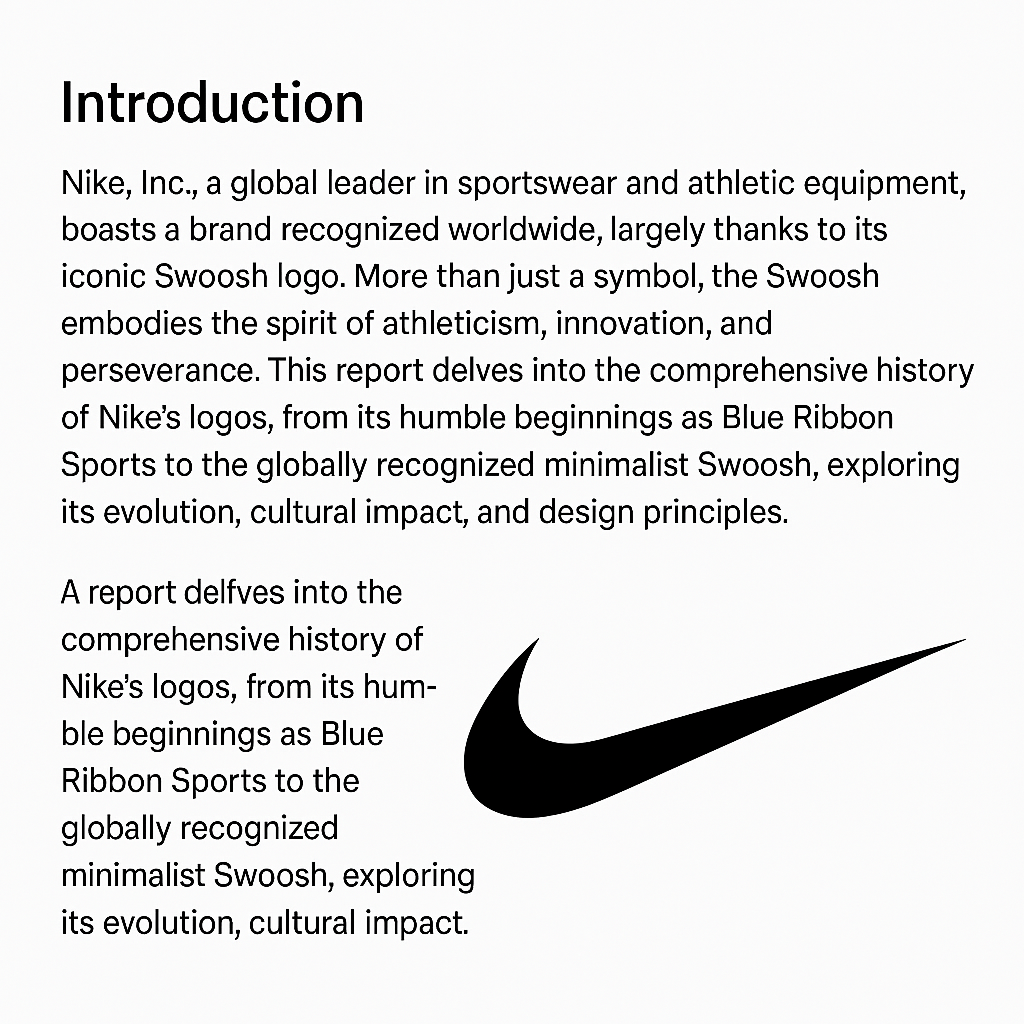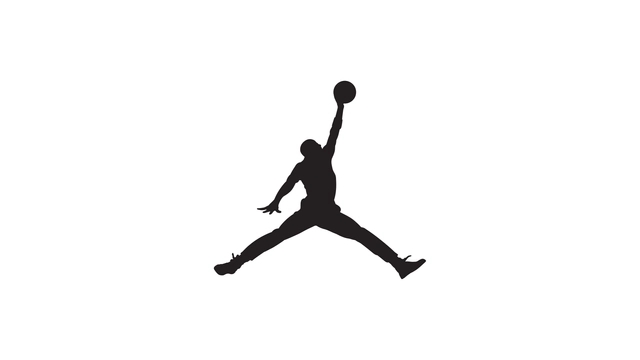The History and Evolution of the Nike Swoosh Logo
Introduction to the Nike Swoosh
Nike, Inc., a global leader in sportswear and athletic equipment, boasts a brand recognized worldwide, largely thanks to its iconic Swoosh logo. More than just a symbol, the Swoosh embodies the spirit of athleticism, innovation, and perseverance. It represents both motion and emotion, a minimalist mark that whispers “Just Do It” into the subconscious of billions.
This article explores the complete history of Nike’s logos — from its roots as Blue Ribbon Sports to the world-famous minimalist Swoosh — focusing on its evolution, cultural relevance, controversies, and lasting design legacy. Whether you’re an athlete, a sneakerhead, or just someone who once bought Nike socks at Target, you’ve been touched by the Swoosh. And no, that’s not a metaphor.
The Origins of Nike and Its First Logo
From Blue Ribbon Sports to Nike
Nike began in 1964 as Blue Ribbon Sports (BRS), a modest startup founded by University of Oregon track athlete Phil Knight and his coach Bill Bowerman. Their initial hustle? Selling Japanese running shoes (Onitsuka Tigers, now ASICS) out of the back of a car at track meets. Every great empire has a humble beginning. For Rome, it was wolves. For Nike, it was sweaty sneakers in a trunk.
The original logo for BRS was about as thrilling as a gym membership contract: a simple, intertwined “BRS” in sans-serif. No flair. No wings. No swooshing.
But change was coming. In 1971, BRS decided to stop acting as a middleman and start producing its own footwear. The company needed a new name and identity. Phil Knight settled on “Nike,” named after the Greek goddess of victory, perhaps because “Zeus Footwear” sounded like a gladiator cosplay store.
Carolyn Davidson and the Creation of the Swoosh
Enter Carolyn Davidson, a design student at Portland State University. Knight, then a professor there, overheard her lamenting that she couldn’t afford oil paints for class. He offered her a gig designing a logo for his new brand. Davidson got to work, sketching out concepts that embodied speed, agility, and forward momentum. One sketch—a curved checkmark-like shape inspired by the wing of the goddess Nike—caught Knight’s eye.
“I don’t love it,” he reportedly said, “but it will grow on me.”
That $35 payment for the logo? Equal to roughly $250 today. But Nike later gave Davidson a diamond Swoosh ring and stock in the company. So yes, it grew on him. And her bank account.
The Swoosh made its debut on the Nike Cortez running shoe in 1971, a shoe that would go on to become a pop culture icon in its own right—thanks, Forrest Gump.
Nike Logo Evolution: From 1971 to Today
Like any athlete at the top of their game, the Swoosh hasn’t stood still. It’s evolved. Trimmed. Toned. Branded. Let’s take a walk through the Swoosh’s style timeline.
1971–1978: Building the Brand Identity
The earliest Nike logo wasn’t just the Swoosh. It also had a chunky, all-uppercase “NIKE” wordmark perched above the curve like it was riding a minimalist surfboard. The typography was brash, confident, and unmistakably ’70s. It was the disco ball of logo fonts.
1978–1985: Streamlining the Design
As Nike gained traction, the logo evolved. The Swoosh became bolder, more aerodynamic, and better proportioned. The wordmark shifted to Futura Bold—cleaner and more geometric. This era birthed silhouettes like the Air Tailwind, and the brand became synonymous with serious athletic performance.
1985–1995: The “Just Do It” Revolution
Cue the drama. This was the era when Nike launched the Air Jordan line and turned sneaker culture into religion. In 1988, the slogan “Just Do It” was introduced, thanks to ad wizard Dan Wieden, who allegedly borrowed the phrasing from the final words of a death row inmate. Talk about making a statement.
The Swoosh gained color—often appearing in red for passion and boldness. It also started appearing alongside high-profile athletes and in gritty, emotional commercials that looked like they belonged in film festivals.
1995–Present: Minimalist Branding
Eventually, the Swoosh ditched the wordmark entirely. Like Prince, it became a symbol that needed no name. The brand’s confidence allowed the Swoosh to stand alone, floating like a visual mantra on shoes, shirts, ads, and social media avatars.
It now exists in black, white, or whatever color the product line demands. Whether it’s on Serena’s gear, LeBron’s kicks, or a toddler’s hoodie, the Swoosh communicates the same message: you’re part of something bigger.
Design Principles Behind the Swoosh Logo
Why does the Swoosh work? Because it follows five timeless design commandments:
- Simplicity: It’s clean, unfussy, and easy to draw with your finger on a foggy mirror.
- Versatility: It works at any scale—from a billboard in Times Square to a wristband.
- Motion: The curve suggests speed, acceleration, and agility.
- Emotional Connection: Paired with Nike’s messaging, it evokes grit, ambition, and momentum.
- Timelessness: The Swoosh hasn’t needed a dramatic redesign in 50+ years. Try naming another logo with that kind of streak.
Cultural Impact of the Nike Logo
The Swoosh is more than a logo. It’s an idea. A movement. A statement. It’s become a cultural signifier like the Cross, the Peace sign, or the McDonald’s arches. Only cooler.
1. Global Recognition
You can go to Tokyo, Nairobi, or Buenos Aires and point to the Swoosh—and someone will say, “Nike.” It transcends language. It’s the Rosetta Stone of sports branding.
2. Symbol of Athleticism
Nike has always aligned itself with champions. From Michael Jordan and Serena Williams to Simone Biles and Cristiano Ronaldo, the brand built a Mount Olympus of modern-day gods and goddesses. The Swoosh isn’t just what they wear. It’s part of their mythology.
3. Motivational Messaging
“Just Do It” remains one of the most powerful slogans ever written. It’s aspirational, adaptable, and universal. Whether you’re running a marathon or just running errands, the Swoosh tells you, “You got this.”
4. Pop Culture Status
From rap videos to skate parks, the Swoosh has seeped into music, art, fashion, and streetwear. It’s been spoofed, tattooed, gilded in gold, and immortalized in murals. It’s both luxury and rebellion.
5. Brand Loyalty
Nike fans don’t just buy sneakers. They buy into a belief system. The Swoosh says, “You belong here.” Whether you’re a pro athlete or a couch-to-5K hopeful, you’re part of the same tribe.
Famous Logo Collaborations and Variations
Nike’s logo doesn’t live in a vacuum. It thrives in collaboration, remix, and reinterpretation.
1. Air Jordan “Jumpman”
Technically a separate logo, the Jumpman silhouette of Michael Jordan mid-dunk is often paired with the Swoosh on shoes and gear. It’s basketball royalty. It’s logo inception.
2. Nike SB
For the skateboarding line, the Swoosh gets attitude. Nike SB graphics have embraced graffiti, street art, and subculture while keeping the Swoosh at the core.
3. Athlete Logos
Nike has created custom branding for megastars like LeBron James (crown + initials), Serena Williams (elegant SW monogram), and the late Kobe Bryant (the Sheath symbol). These personal emblems often appear alongside or in place of the Swoosh.
4. Move to Zero
Nike’s sustainability campaign features a modified circular Swoosh to symbolize Earth-friendly innovation. Because even logos are going green.
Controversies Surrounding the Nike Logo
No great icon survives unscathed. The Swoosh has flown through a few turbulence zones.
1. 1997 Arabic Design Backlash
A Nike Air model’s flame-like design appeared to resemble the Arabic word for “Allah,” sparking protests. Nike apologized and recalled thousands of products. Lesson learned: every curve has consequences.
2. 2019 Betsy Ross Flag Controversy
Nike pulled a limited-edition sneaker featuring the 13-star colonial American flag after concerns about its connection to racism and white nationalism. The decision divided public opinion but solidified Nike’s stance on social issues.
3. Minor Threat Lawsuit
Nike used imagery mimicking the punk band Minor Threat in a marketing campaign. Fans (and the band) weren’t thrilled. Punk and corporate synergy do not mix well.
What’s Next for the Swoosh?
Nike has no plans to change the Swoosh anytime soon (and why would they?), but the context in which it appears is evolving.
1. Digital Optimization
The Swoosh is being adapted for apps, smartwatches, and even AR/VR environments. It must look just as sleek on a 6-inch screen as it does on a 60-foot banner.
2. Sustainability Integration
Expect more green-themed variants and logos associated with sustainable collections. Think: recycled materials, carbon-neutral production, and minimalist packaging with maximum impact.
3. Metaverse Expansion
Nike has already filed patents for virtual goods and launched NFT-based projects. Animated Swooshes might soon be running through your digital wardrobe.
4. Collaborative Branding
Look for more athlete-artist crossovers, from Travis Scott to Billie Eilish. Each puts a new spin on the brand while keeping the Swoosh front and center.
Conclusion: Why the Swoosh Is an Icon
From a $35 sketch to a symbol that drives billions in revenue, the Nike Swoosh has transcended the category of “logo.” It’s become a piece of visual poetry — minimal, powerful, and instantly motivational.
It tells a story without words. It represents movement, courage, grit, and style. It belongs on an Olympic podium, a schoolyard soccer field, and a fashion runway. It unites athletes and dreamers, the elite and the everyday.
Because when you see the Swoosh, you don’t just see a brand. You see possibility.
So whether you’re lacing up your Jordans, tying your Flyknits, or sliding into a pair of Blazers, remember: every step you take has a Swoosh-shaped spark behind it.
Just Do It.
Want a logo that stands the test of time? Explore our logo generator and start playing around with ideas for your own logo!

